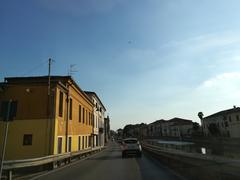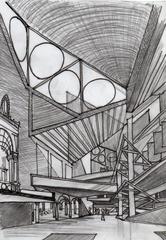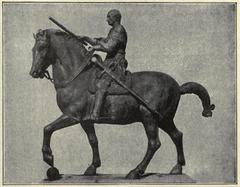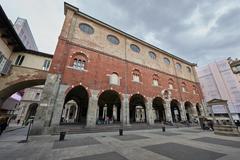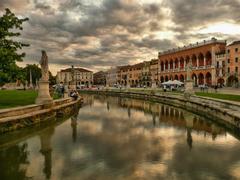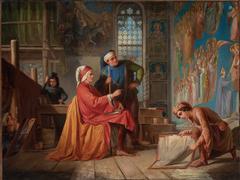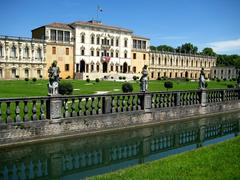Comprehensive Guide to Visiting Duomo di Padova, Padua, Italy
Date: 19/07/2024
Introduction
The Duomo di Padova, also known as the Cathedral of Padua, stands as a beacon of history, art, and spirituality in Padua, Italy. This magnificent cathedral is not only an epitome of architectural grandeur but also a repository of rich historical narratives dating back to the early Christian period. Constructed initially in the 4th century on the foundations of a Roman temple, the Duomo di Padova has undergone numerous transformations that mirror the cultural and architectural evolution of the region (Turismo Padova). From the devastating earthquake in 1117 that led to its medieval reconstruction, to the Renaissance redesign by Andrea della Valle and the Baroque and Neoclassical additions, the cathedral reflects a blend of various architectural styles. Notably, Michelangelo’s influence on the dome’s design adds a layer of artistic significance to this historical monument (Duomo Padova). Today, the Duomo di Padova serves as the seat of the Bishop of Padua, an active place of worship, and a major tourist attraction drawing visitors from around the world to admire its architectural beauty and historical significance.
Table of Contents
History of Duomo di Padova
Early Beginnings
The Duomo di Padova has a rich history that dates back to the early Christian period. The original cathedral was constructed in the 4th century, making it one of the oldest Christian sites in the region. This early structure was built on the foundations of a Roman temple, reflecting the transition from paganism to Christianity in the area. The cathedral was dedicated to Santa Maria Assunta, a dedication that has remained through the centuries.
Medieval Reconstruction
The cathedral underwent significant changes during the medieval period. In 1117, a devastating earthquake struck Padua, causing extensive damage to the original structure. The reconstruction efforts led to the creation of a Romanesque-style cathedral, which was completed in the 12th century. This version of the Duomo featured a more robust and fortified design, typical of Romanesque architecture, with thick walls and small windows.
Renaissance Transformation
The most significant transformation of the Duomo di Padova occurred during the Renaissance. In the 16th century, the cathedral was once again in need of repair and modernization. The renowned architect Andrea della Valle was commissioned to design a new structure. His plans included a grandiose façade and a spacious interior, reflecting the Renaissance ideals of symmetry, proportion, and beauty. However, della Valle’s design was only partially realized due to financial constraints and his untimely death.
Contributions of Michelangelo
One of the most intriguing aspects of the Duomo’s history is the involvement of Michelangelo. Although he never visited Padua, Michelangelo provided sketches and designs for the cathedral’s dome. His influence is evident in the grandeur and elegance of the dome, which remains one of the most striking features of the Duomo. The dome was completed in the late 16th century, long after Michelangelo’s death, but it stands as a testament to his enduring legacy.
Baroque and Neoclassical Additions
The 17th and 18th centuries saw further modifications to the Duomo di Padova. Baroque elements were introduced, including ornate altars and chapels. The interior was adorned with elaborate stucco work and frescoes, adding to the cathedral’s splendor. In the 19th century, neoclassical elements were incorporated, particularly in the design of the façade. These additions aimed to harmonize the various architectural styles that had been introduced over the centuries.
World War II and Restoration
The Duomo di Padova, like many historical buildings in Europe, suffered damage during World War II. Bombing raids in 1944 caused significant harm to the structure, particularly the roof and the dome. Post-war restoration efforts were extensive and aimed at preserving the historical integrity of the cathedral. The restoration work was completed in the 1950s, and the Duomo was reopened to the public.
Modern-Day Significance
Today, the Duomo di Padova stands as a symbol of the city’s rich historical and cultural heritage. It continues to serve as the seat of the Bishop of Padua and is an active place of worship. The cathedral is also a major tourist attraction, drawing visitors from around the world who come to admire its architectural beauty and historical significance.
Notable Artworks
The Duomo houses several notable artworks, including the “Assumption of the Virgin” by Andrea Mantegna, a masterpiece of Renaissance art. The cathedral’s chapels are adorned with frescoes and sculptures by various artists, reflecting the artistic evolution of the region. These artworks provide a glimpse into the rich artistic traditions of Padua and the broader Veneto region.
Archaeological Discoveries
Recent archaeological excavations around the Duomo have uncovered remnants of the original 4th-century structure, as well as Roman artifacts. These discoveries have provided valuable insights into the early history of Padua and the development of the Christian community in the region. The findings are displayed in the cathedral’s museum, offering visitors a deeper understanding of the site’s historical significance.
Architectural Features
The Duomo di Padova is renowned for its architectural features, which include a mix of Romanesque, Renaissance, Baroque, and Neoclassical elements. The cathedral’s façade, with its grand columns and pediment, is a striking example of neoclassical design. The interior features a spacious nave, side chapels, and a magnificent dome, all of which reflect the various architectural styles that have influenced the cathedral over the centuries.
Visitor Information
Visiting Hours
The Duomo di Padova is typically open to visitors from 7:30 AM to 12:30 PM and from 3:30 PM to 7:00 PM. It’s advisable to check the official website or contact the cathedral directly for the most up-to-date information on visiting hours, especially during holidays and special events.
Ticket Prices
Admission to the Duomo di Padova is generally free, but donations are appreciated to help with the maintenance and preservation of the cathedral. Some special exhibitions or guided tours may have a nominal fee.
Guided Tours
Guided tours are available and highly recommended for those who wish to gain a deeper understanding of the Duomo’s history and architectural significance. Tours can be booked through the official Padua Tourism website or directly at the cathedral.
Accessibility
The Duomo di Padova is accessible to visitors with disabilities. There are ramps and elevators available to ensure that everyone can enjoy the beauty and history of this magnificent cathedral.
Nearby Attractions
The Duomo di Padova is located in the heart of Padua, a city rich in history and culture. Nearby attractions include the Scrovegni Chapel, known for its stunning frescoes by Giotto, and the Basilica of Saint Anthony, a pilgrimage site. The historic University of Padua, one of the oldest universities in the world, is also worth a visit.
Travel Tips
Best Times to Visit
The Duomo is less crowded in the early morning and late afternoon. Visiting during these times can provide a more peaceful and contemplative experience. Spring and autumn are the best seasons to visit Padua, as the weather is mild and the city is less crowded with tourists.
What to Wear
As a place of worship, visitors are expected to dress modestly. Shoulders and knees should be covered. Comfortable walking shoes are recommended, as there is much to explore in and around the cathedral.
FAQ
What are the Duomo di Padova visiting hours?
The Duomo di Padova is typically open from 7:30 AM to 12:30 PM and from 3:30 PM to 7:00 PM. Check the official website for the most current information.
Is there an admission fee?
Admission to the Duomo is generally free, but donations are appreciated. Some special exhibitions or guided tours may have a fee.
Are guided tours available?
Yes, guided tours are available and can be booked through the official Padua Tourism website or directly at the cathedral.
Is the Duomo accessible to visitors with disabilities?
Yes, the Duomo is accessible, with ramps and elevators available to ensure everyone can visit.
Conclusion
Visiting the Duomo di Padova offers a multifaceted experience that encompasses historical, architectural, and cultural exploration. This iconic cathedral, with its rich tapestry of history from the early Christian period to modern-day significance, provides a unique insight into the evolution of Padua. Whether it is the Renaissance transformation by Andrea della Valle, the Baroque and Neoclassical additions, or the artistic contributions of Michelangelo, the Duomo di Padova stands as a testament to the region’s enduring legacy (Turismo Padova). For those planning a visit, the cathedral’s accessible visitor information, including guided tours, nearby attractions, and travel tips, ensures a memorable and enriching experience. As you explore this monumental site, you not only witness its architectural grandeur but also become a part of its ongoing historical narrative. Don’t miss the opportunity to delve into the rich artistic heritage and serene spirituality that the Duomo di Padova offers (Duomo Padova).


